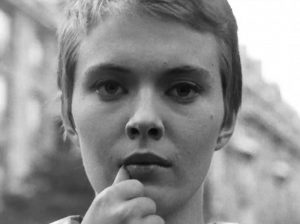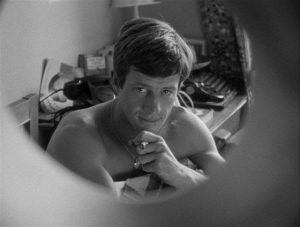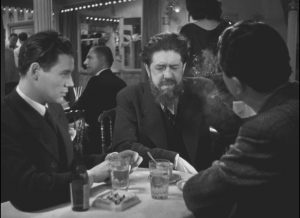Nemanja Milosevic on Breathless (1960)
The fast paced, 90 minutes long, black and white movie Breathless (À bout de souffle), features the escapades of its protagonist Michel, but most of all is a quintessential representation of the New Wave, the French movement in cinema. Besides Michel, we are introduced to Patricia, a young American journalist, trying to succeed in Paris.
This fast paced crime drama is based on the two components of the plot, first the criminal activities of Michel, that consist of stealing cars and murdering one policeman, and the other being his obsession with Patricia. The majority of film we witness just that, him stealing cars and his interaction with Patricia, who is not so sure about her own feelings toward her French lover. Patricia is confronted by the detective who is working on the case of the murdered policeman and blackmails Patricia with her alien status in France that would be in danger should she not reveal whereabouts of her lover.
Patricia is confronted morally, but decides to betray Michel and calls the police giving them information about him. The movie ends with Michel trying to escape, running down the street and being shot from the back. The very last shot we see is Patricia’s face while she is looking at him, sliding her nail across her lips.

As mentioned before, Breathless is the emblem of the French cinematic movement called New Wave. The movement was considered by its members not as something organized and institutionalized, but just a large group of directors creating quality films. The decline of mainstream French cinema after the World War 2, mostly caused by administrative and regulatory reasons, provoked several members of Cinemathequeto foster the future growth of the new direction, represented by movies made by Jean-Luc Godard, Francois Truffaut, Jacques Rivette, Jacques Doniol Valcroze and Claude Chabrol.
One of the main points of the movement was the reconstruction of the film language, previously misused and proved to be a dangerous tool (especially during the World War 2). Cinema developed, in the course of previous decades, a set of conventions and grammar that aimed at making the spectator unaware of the mere experience of watching the moving images. That means that the main goal was to make a spectator feel like the movie is part of the reality, that the chain of events happening on screen is not part of the medium they are watching, something prerecorded, but reality taking place right there, in front of our eyes. This led to strong emotions from people who were not able to process the movie properly as fiction. This type of moviemaking resulted in a certain amount of power that directors and producers have to use the medium in manipulative ways, in order to achieve certain ideological or political goal.

Like in the time that led to Breathlessand New Wave, today we face a very big divide between commercial and more independent cinema. In the city where I live this divide is most visible in the way movie theaters work. There are shopping mall based high-end cinemas that are usually more expensive and have a whole industry of on-the-side entertainment to it, like 3D, food court, collection of points, etc. On the other hand, small cinema and cultural centers downtown Belgrade offer a variety of European and less known movies that are not meant to be seen in 3D and do not include any of side entertainment. These independent cinemas do not show trailers before movies or try to lure audience with commercials, and projections start right on time.
The divide is therefore greater, since the identity of the place that shows movies corresponds with the offer, so you will not be able to go to high-end commercial cinema for a movie that’s not from a major production company from the USA.
Another very important aspect of it is the loss in creativity that this causes. The innovation is lacking from contemporary commercial cinema, in a way in which most movies can be seen as having some kind of a mutual formula. This kind of a universal formula that fits many different movies can be, in a way, applied on many contemporary films as well.
The current trend of movies based on the conflict between good and evil (like superhero movies), that again follows the same structure or formula, goes even further, as it uses the visual effects to compensate for the lack of boldness and originality. Also, the infamous superhero genre may use identity politics to acquire certain kind of prestige that may not be usually attributed to this genre, like “Wonder Woman” or “Black Panther”, that were almost universally critically acclaimed, with the score of more than 90% on Rotten Tomatoes (a website that measures the amount of favorable critiques from professional movie critics), but still, does not go far away from the limitations of the superhero genre.
This kind of a trend I see as a result of a highly capitalistic way of producing movies. The big production companies have stablished a certain market with their target group that is pretty loyal (loyalty is built by having a brand, like Marvel) and there is a certain set of elements of the plot that usually bring profit, so introducing new elements, changing the existing ones and going “off script” would be a big risk for a profit that is already guaranteed. That is how a big capital is held within a certain niche, without overcoming its limits in the highly competitive market.

Why did I talk about it this while discussing the movie Breathless? Because the movie aimed at provoking the established power structure within cinema, dealt with the history of a medium in a way where self-reflection and meta reference was a crucial element to deconstruct the “seductiveness” of the film, show and educate the audience on how the medium works and what techniques does it use to seduce. We now, in the contemporary world, have a situation where conformity plays a very important role, and everything that is not part of it is being marginalized. We almost have one powerful center with a lot of resources, that is doing everything it can to preserve the position of power, and the periphery with less resources that caters to the niche audience, usually in small downtown cinemas. The way New Wave dealt with movie conventions that were meant to mask the fact that we are watching a movie and tried to expose it in a original way is what I appreciate about it, as someone who watches movies in 2018 and sees a lot of similarities to the crisis. Breathlessis a non-commercial movie that left a really big mark in the history of the movie by being bold and rebellious towards itself, it is an example of anti-capital oriented, non-crowd-pleasing piece that ended being a widely recognizable title even half a century later.









